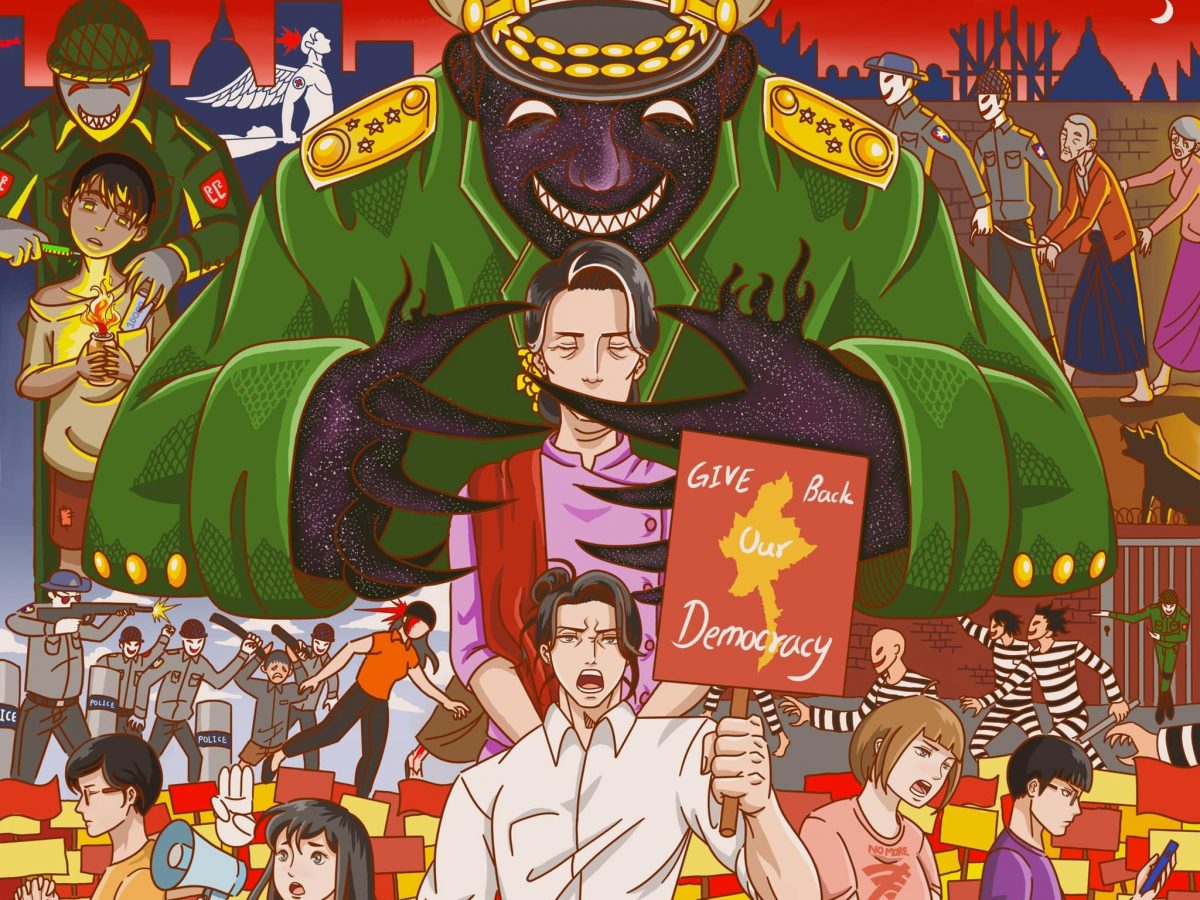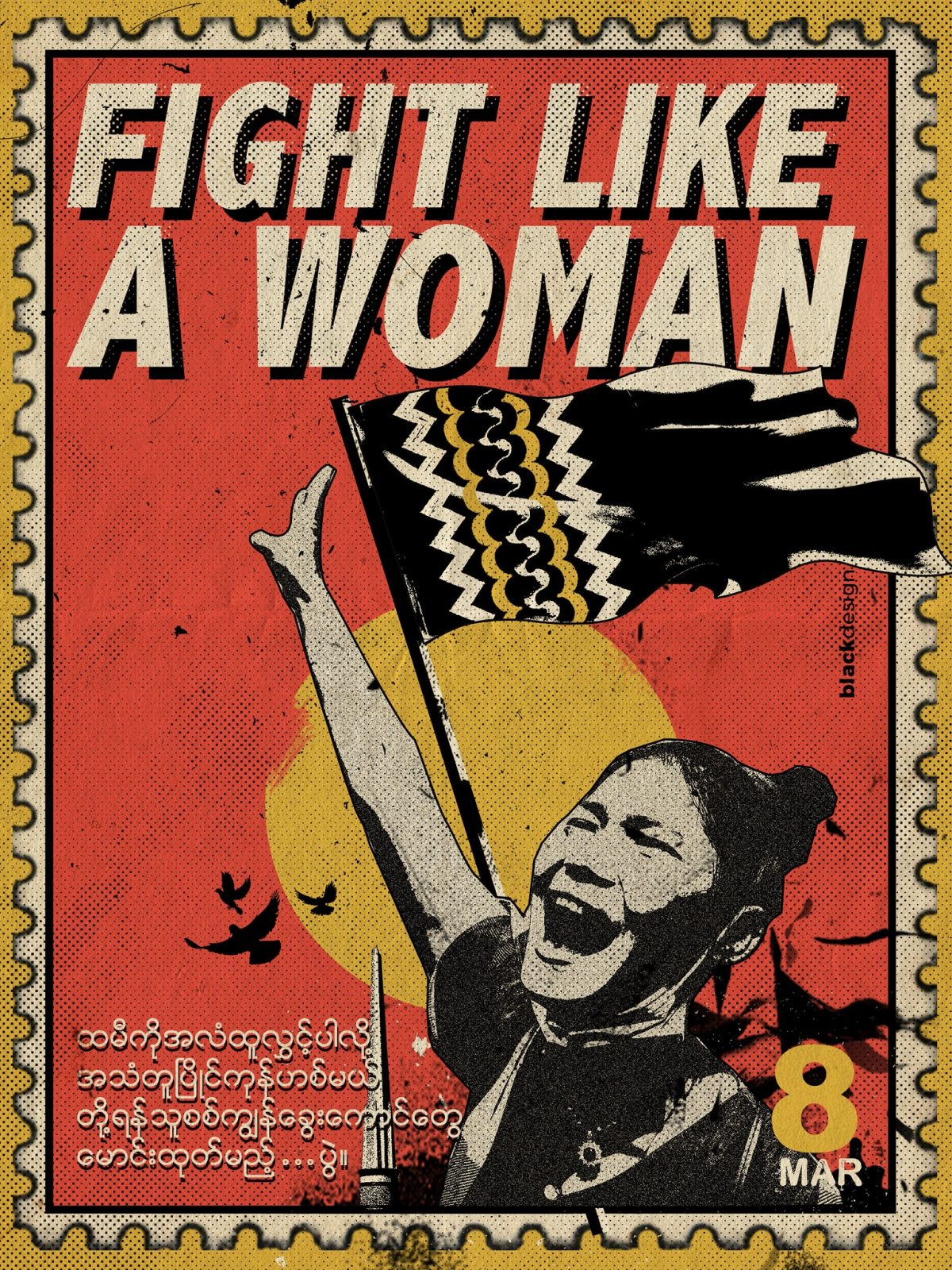
The roar of demonstrators has been echoing in the streets of Myanmar for over a month now as civilians continue to protest the Feb. 1 military coup against the democratically elected leader Aung San Suu Kyi. As Myanmar police continue to use violence and brutal crackdowns against peaceful protesters, unexpected allies stand out from the troops fighting for democracy at the front lines: artists.
Thousands of demonstrators recently marched in Yangon and Mandalay, Myanmar’s biggest cities, as well as other cities across the country, as part of another nationwide strike to keep up the fight for the pro-democracy movement. Since the military seized power and declared a yearlong state of emergency, the death toll from protests continues to rise. The Assistance Association for Political Prisoners reports that at least 54 people have been killed since the coup and nearly 1,800 have been arrested.

Amid heavy military presence and constant raids and arrests, a wave of art is emerging from the crowds. Artists are using their skills to share the message of the opposition’s Civil Disobedience Movement with the world.
“Art is not only a tool against the government, but also a record to reflect on the recent situation,” Khin Zaw Latt, a Yangon-based artist, told Artnet News. “It is a part of history.”
Artists took to the streets holding up cutouts of cartoon characters denouncing the actions of the military. Others held an art-making protest event in Yangon to support the pro-democracy moment. They are calling for support from fellow artists around the world, requesting paintings, performances, posters, and any other artworks to participate in the movement. Several online art collectives have made their designs available online for free so that protesters can use them for signs. A group of 30 artists from Myanmar uploaded over a hundred posters to the website yangon.design for free print and use. “Like all other Myanmar citizens, artists want to contribute to the national struggle… [we] can assist other protesters with our art. [Protesters] can bring the posters to the streets or hang them on walls,” a representative of the collective said.

“Artists in Myanmar have courageously brought the fight to the streets and to the airwaves, using their art to project the nation’s voice, to depict its fears, and above all, to scream hope,” a message reads on the Art for Freedom site. “Our archive showcases that art, and calls on artists around the world to amplify the voices of the Myanmar people. The louder the volume, the harder it is for those seeking to steal the future to succeed.” Among the wide variety of art collected from artists across the world, common themes and symbols seem to emerge. Many of the artworks show hands arranged in the three-finger salute from The Hunger Games. Protesters have looked to tactics and slogans from movements in Hong Kong and Thailand for inspiration, where The Hunger Games’ three-finger salute became popularized last year during Thailand’s democracy movement.

Many artworks are notably in red, which is the color of Aung San Suu Kyi’s party. Others show Myanmar residents banging pots and pans – traditionally a way to drive out the devil – against the coup. At 8 p.m. every night, civilians pound pots and pans in many parts of the country. Doing this also allows for the broader participation of civilians during an ongoing pandemic, including women. According to The Interpreter, pots and pans movements have historically encouraged women’s participation in politics.

“I want everyone from all over the world to notice [our situation],” an artist who goes by the name Mg Pyi Thu told the BBC. “I want them to know that we strongly condemn the actions of the military. I don’t want to live under a dictatorship. I want to live a peaceful life.”
To understand the significance of this movement, it is worth taking a look at Myanmar’s history with the military and democracy. Myanmar, also known as Burma, suffered decades of authoritarian military rule until a transfer to civilian leadership in 2011. While this shift spurred hopes of democratic reforms, the military still maintained control over parts of the government. In 2015, the country held its first nationwide, multiparty election since 2011. These are considered to be the freest and fairest elections Myanmar held in decades, according to the Council on Foreign Relations. That’s when Aung San Suu Kyi was elected Myanmar’s de facto leader. In 2020, the country held its second national elections, which Aung San Suu Kyi’s party, the National League for Democracy party, overwhelmingly won. Military leaders alleged voter fraud, and after the country’s election commission rejected the military claims, it staged a coup on Feb. 1, 2021. And here we are today. Senior General Min Aung Hlaing is expected to take charge of the country during the yearlong state of emergency until new elections are held – but experts say the military could maintain power indefinitely.
A week after the army ousted Aung San Suu Kyi’s government, Myanmar’s new junta proposed a new cybersecurity law that would give unprecedented censorship powers and violate privacy, contravening democratic norms and fundamental rights, the Asia Internet Coalition says. Under the proposed bill, internet providers would have to prevent or remove content deemed to “cause hatred, destroy unity and tranquility,” – a direct threat to artists and many Myanmar residents who took to social media to protest peacefully.
View this post on Instagram
The international response to the putsch so far has been irregular. But as images of the violence used against demonstrators are spreading online, calls for a stronger international response are growing. According to AP, the United Nations Human Rights Chief said it was time to “end the military’s stranglehold over democracy in Myanmar.” Some countries have imposed or threatened to impose sanctions following the coup. However, any kind of coordinated action at the United Nations seems difficult since two members of the Security Council, China and Russia, would most likely veto it.
In spite of everything, artists are still determined to keep using the power of their art to mobilize a global audience and grow awareness.
View this post on Instagram


